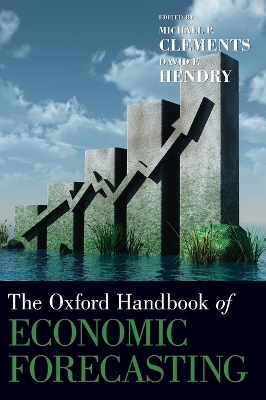
The Oxford Handbook of Economic Forecasting
Oxford University Press Inc (Verlag)
978-0-19-539864-9 (ISBN)
This Handbook provides up-to-date coverage of both new developments and well-established fields in the sphere of economic forecasting. The chapters are written by world experts in their respective fields, and provide authoritative yet accessible accounts of the key concepts, subject matter and techniques in a number of diverse but related areas. It covers the ways in which the availability of ever more plentiful data and computational power have been used in forecasting, either in terms of the frequency of observations, the number of variables, or the use of multiple data vintages. Greater data availability has been coupled with developments in statistical theory and economic theory to allow more elaborate and complicated models to be entertained; the volume provides explanations and critiques of these developments. These include factor models, DSGE models, restricted vector autoregressions, and non-linear models, as well as models for handling data observed at mixed frequencies, high-frequency data, multiple data vintages, and methods for forecasting when there are structural breaks, and how breaks might be forecast.
Also covered are areas which are less commonly associated with economic forecasting, such as climate change, health economics, long-horizon growth forecasting, and political elections. Econometric forecasting has important contributions to make in these areas, as well as their developments informing the mainstream. In the early 21st century, climate change and the forecasting of health expenditures and population are topics of pressing importance.
Michael P. Clements is Professor of Economics at the University of Warwick. His research interests include econometric modelling and forecasting, with recent publications in the areas of forecast evaluation, the analysis of high frequency data and mixed data frequency models, real-time vintage data, and survey expectations. He currently serves as an editor of the International Journal of Forecasting. David F. Hendry is a Fellow of Nuffield College and Professor of Economics, University of Oxford (Chairman, 2001-2007). He was Knighted in 2009, and holds seven Honorary Doctorates. He is an Honorary Vice-President and past President, Royal Economic Society; Fellow, British Academy, Royal Society of Edinburgh, Econometric Society, and Journal of Econometrics; Foreign Honorary Member, American Economic Association and American Academy of Arts and Sciences; and an Honorary Fellow, International Institute of Forecasters.
Introduction. Michael Clements and David Hendry ; Part 1. Forecasting models and methods ; 1. VARs, cointegration and common cycle restrictions ; Heather Anderson and Farshid Vahid ; 2. Dynamic factor models ; James Stock and Mark Watson ; 3 Forecasting with non-linear models ; Anders Kock and Timo Terasvirta ; 4 Forecasting with DSGE models ; Kai Christoffel , Gunter Coenen and Anders Warne ; 5 Unobserved components ; Siem Jan Koopman and Marius Ooms ; 6 Judgmental forecasting ; Paul Goodwin, Dilek Onkal and Michael Lawrence ; Part 2. Data issues ; 7 Nowcasting ; Marta Ba?bura, Domenico Giannone and Lucrezia Reichlin ; 8 Forecasting with mixed-frequency data ; Elena Andreou, Eric Ghysels and Andros Kourtellos ; 9 Forecasting with real-time data vintages ; Dean Croushore ; Part 3. Forecasting and Structural breaks ; 10 Forecasting and structural breaks ; Michael Clements and David Hendry ; 11 Forecasting breaks and forecasting during breaks ; Jennifer Castle, David Hendry, and Nicholas Fawcett ; 12 Forecast combination ; Marco Aiolfi, Carlos Capistran and Allan Timmermann ; Part 4. Forecast evaluation ; 13 Multiple forecast model evaluation ; Valentina Corradi and Walter Distaso ; 14 Testing for unconditional predictive ability ; Todd Clark and Michael McCracken ; 15 Testing for conditional predictive ability ; Raffaella Giacomini ; 16 Interpreting and Combining Heterogeneous Survey Forecasts ; Charles Manski ; 17 Use and Evaluation of Panels of Forecasts ; Antony Davies, Kajal Lahiri and Xuguang Sheng ; Part 5. Financial forecasting ; 18 Forecasting Financial Time Series ; Terence Mills ; 19 Volatility Forecasting Using High Frequency Data ; Peter Hansen and Asger Lunde ; Part 6. Special Interest Areas ; 20 Economic value of weather and climate Forecasts ; Richard Katz and Jeff Lazo ; 21 Long-horizon Growth forecasting And Demography ; Thomas Lindh ; 22 Energy Market forecasting ; Derek Bunn and Nektaria Karakatsani ; 23 Models for Health Care ; Andrew Jones ; 24 Political and election forecasting ; Michael Lewis-Beck and Charles Tien ; 25 Marketing & sales ; Philip-Hans Franses
| Reihe/Serie | Oxford Handbooks |
|---|---|
| Zusatzinfo | 49 line drawings |
| Verlagsort | New York |
| Sprache | englisch |
| Maße | 249 x 180 mm |
| Gewicht | 1333 g |
| Themenwelt | Mathematik / Informatik ► Mathematik ► Angewandte Mathematik |
| Wirtschaft ► Volkswirtschaftslehre ► Mikroökonomie | |
| Wirtschaft ► Volkswirtschaftslehre ► Ökonometrie | |
| ISBN-10 | 0-19-539864-5 / 0195398645 |
| ISBN-13 | 978-0-19-539864-9 / 9780195398649 |
| Zustand | Neuware |
| Haben Sie eine Frage zum Produkt? |
aus dem Bereich


